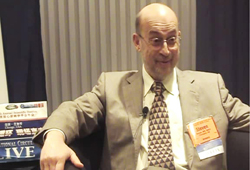 Steven E. Nissen教授
Steven E. Nissen教授
医学博士,美国克利夫兰临床中心(俄亥俄州)心血管医学部主任。是开展血管内超声(IVUS)的先驱者之一,主要研究方向为影像技术。2007年被美国《时代》周刊评为“世界100位最有影响力人物”之一。2006年3月至2007年3月,为美国心脏病学会(ACC)主席。
AHA2008年会期间,Nissen教授接受了《国际循环》编辑部的电话采访。
International Circulation: The mechanisms that underlie adverse cardiovascular outcomes in diabetic patients have not been well characterized. I have read some of your articles on this issue. Would you like to tell us the characteristics of diabetic patient’s coronary artery?
《国际循环》:糖尿病患者心脏疾病预后不佳的机制还不清楚。我曾经读过您的一些相关文章,能否介绍一下您的研究中糖尿病患者冠状动脉病变的特点?
Prof. Steven Nissen: We know that diabetics have a significant increase in the risk of major adverse cardiovascular outcomes, including death, heart attack, stroke, and revascularization. We have done some studies using intravascular ultrasound (IVUS) that have demonstrated that they also have a substantially greater rate of the development of atherosclerosis. The rate of progression of their disease, once it is present in the coronary arteries, is much greater than non-diabetics. This we think probably plays an important role in the high risk for adverse cardiovascular outcomes. Surprisingly, the mechanisms by which having a high blood sugar increases the risk of adverse cardiovascular events is not entirely understood. Certainly there are abnormalities in lipid metabolism. Although LDL cholesterol is often not particularly elevated, HDL cholesterol is often low in these patients, and triglycerides are often high. Therefore, the combination of high triglycerides and low HDL may play a role. There is a higher incidence of hypertension in diabetics, and so with more hypertension, and lower HDLs, and higher triglycerides, diabetics are much more likely to have the metabolic syndrome than non-diabetics. Finally, there are advanced glycation end products (AGEs) that may be produced by high blood sugar that are involved in abnormalities in the vessel wall that may also lead to accelerated atherosclerosis.
Steven Nissen教授: 我们知道糖尿病患者发生不良心血管事件的风险显著增加,包括死亡、心脏病发作、卒中以及血运重建。我们利用血管内超声(IVUS)做了一些研究,证实他们发生动脉粥样硬化的比例更高。糖尿病患者一旦出现冠状动脉粥样硬化会比非糖尿病患者进展更快。 我们认为这是导致不良心血管事件高发的主要原因。然而,高血糖增加不良心血管事件风险的机制仍不明确。当然脂质代谢异常是其中一项原因。虽然LDL胆固醇通常不是显著升高,但这些患者通常HDL胆固醇降低,甘油三脂升高。因此,高甘油三脂和低HDL也在其中发挥作用。糖尿病患者高血压发病率更高。高血压、低HDL和高甘油三脂使得糖尿病患者较非糖尿病患者更易患代谢综合征。最后,高血糖产生的糖基化终产物会导致血管壁异常,也可能加速动脉粥样硬化进展。
International Circulation: The REVERSAL (Reversal of Atherosclerosis with Aggressive Lipid Lowering) study was designed to test the hypothesis that circulating biomarkers of oxidized low-density lipoprotein (OxLDL) are affected by statin therapy and predict changes in atheroma volume. Statin therapy resulted in significant increases in OxPL/apoB, MDA/apoB, and lipoprotein (a) levels and decreases in apoB immune complexes and OxLDL autoantibodies. However, these measures did not correlate with changes in QCA parameters or atheroma volume. Could you explain these results for us?
《国际循环》:REVERSAL研究提示他汀治疗可以提高OxPL/apoB、MDA/apoB和脂蛋白a还可以降低载脂蛋白B免疫复合物和氧化型低密度脂蛋白(OxLDL)自身抗体。但这种改变对于患者管腔面积没有明显变化。请问您是如何看待这一结果?
Prof. Steven Nissen: We do not know the answers. This was a sub-study based upon banked blood of the REVERSAL trial. The main result of the REVERSAL trial, which was published in 2004 in JAMA, was really very striking. What we found was that patients who got an intensive statin regimen with atorvastatin had a slower rate of progression of coronary atherosclerosis than patients who got a more moderate statin regimen based on pravastatin. The attempt of this sub-study was to find out whether measures of oxidized LDL and some more sophisticated measures would be a better predictor of who progressed and who did not, but we really did not see very striking findings. So, we are really back to the original findings of the trial, namely that more LDL lowering produced a better outcome than less LDL lowering. We have also reported that greater reductions in CRP produced better outcomes than lesser reductions in CRP. Beyond that, everything else is really just exploratory.
Steven Nissen教授: 我们不知道答案。这是一个源于REVERSAL试验库存血的分支研究。在2004年JAMA上发表的 REVERSAL试验的主要结果相当惊人。我们发现服用阿托伐他汀进行他汀强化治疗的患者相比服用普伐他汀进行他汀常规治疗的患者,冠状动脉粥样硬化的进展会延缓。这一分支研究尝试了解是否OxLDL和一些更高级的检测手段可以更好地预测动脉粥样硬化的发展,但我们没有特别的发现。因此,我们回到这一实验的最初发现,就是LDL降低的越多,临床效果越好。我们还发现C反应蛋白降得越低,患者的临床转归越好。除此之外,其他的检测指标还有待探索。
International Circulation: Do you have any plans on looking at this further and following up on it?
《国际循环》:对此您还有没有进一步的研究计划?